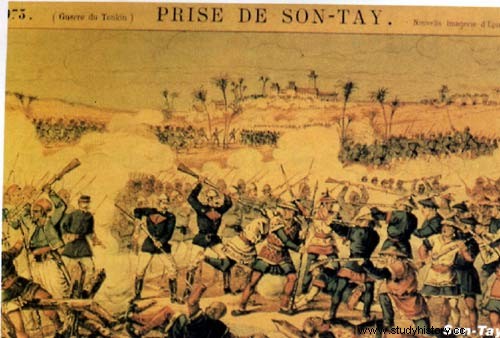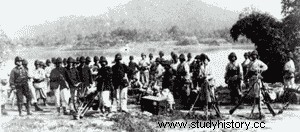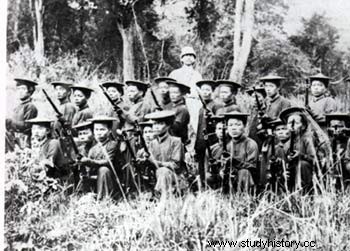-

- Son-Tay
In 1883 the news of the massacre of the cdt riviére and his troops, produced in France an intense emotion. Harassed by public opinion, Jules Ferry's government ordered reprisals. On June 1, 1883, he entrusted Rear-Admiral Courbet - previously governor of New Caledonia, where he had overcome the worst difficulties - with the command of the naval division of the Tonkin coasts, which included two small battleships, seven sloops or gunboats and two torpedo carriers.
-

- Son-Tay
On July 30, Courbet is in Haiphong; on August 16, he declared the Annamese coast in a state of blockade; on August 18, he sailed from Tourane and anchored off the coast of Hué. The landing takes place on August 20; Commander Parayon set off first, followed by 300 sailors and two sections of marine infantry. It progresses despite heavy fire from the forts. After an hour of fighting, during which we counted a few wounded, not a single death, the enemy retreated, leaving 600 corpses on the ground. On August 21, Courbert had the entire evacuated line occupied and imposed an armistice, signed at Hué. In less than three weeks, he avenged Commander Rivière and fulfilled his mission.
-

- Son-Tay
Almost immediately, complications arise; the civil power dithers; the Black Flags regroup and the regular Chinese army joins them:they occupy two powerful fortresses, Son Tay and Bac Ninh. We need reinforcements, these reinforcements are slow, and the Chinese are hastening to take the offensive. Then, Courbet proclaims a state of siege. He prepared his plan and chose Son Tay as his objective, on the banks of the Red River:a citadel built in the style of Vauban, defended by a garrison of 2,000 men commanded by the leader of the Black Pavilions, Lun Vinh Phuoc, who had once massacred Henri Rivière. and his companions.
The men are equipped with modern rifles and the place is defended by 150 guns. What can Courbet oppose to them? Troops made up of disparate elements to excess:Turcos from Algiers, Cochinchinese skirmishers, some elements of the Foreign Legion, supported by five batteries mounted on horseback and two batteries of 65 marines; in total, barely 5,000 fighters. The difference in idioms makes it even more difficult to unite these troops, a veritable army of Babel. But the prestige of the admiral, the strict discipline he imposes on his men - of whom, moreover, he will always be adored - the hard training to which he subjected them overcome all these obstacles.
Son Tay is protected by a belt of villages defended by dykes against rising waters. Two of these dykes meet at Phu-Sa. It is on this last point that Courbet's first effort will focus. On December 11, the French marched on Phu-Sa in two columns, the strongest led by the river under the orders of the admiral himself; the second, commanded by Colonel Belin, taking the land route. At 3 o'clock in the afternoon, the first column landed 500 meters upstream from the confluence of the Day; in the evening, it reaches the dyke and grows strong there. The second column, delayed by the obstacles of the terrain, rallied on December 13, at noon. On December 14, Courbet stormed Phu-Sa and captured it. Despite repeated counterattacks, the Black Flags cannot regain the lost position.
On the strength of this first success, Courbet will now tackle Son Tay. He established himself at the western gate with his four deputies Colonels Bichot, Belin, Badens and Revillon, while our batteries fired on the rear of the defenders. After a few hours of bombardment, the admiral launches his men on the attack, the Foreign Legion in the lead. It's 5 o'clock in the evening. At 6 o'clock, Courbet enters the square and puts an end to the fight; Lun Vinh Phuoc, forever discredited by this failure, retreated with what remained of his soldiers, leaving behind 3,000 men out of action. Our losses amount to 80 dead and 300 wounded.
